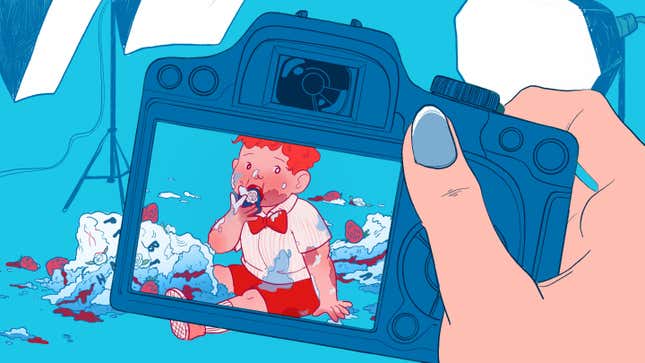
Image: Vicky Leta
When Milwaukee-based food blogger and author Philia Kelnhofer first told her parents that she was making a smash cake for her son’s first birthday, they were confused. “They literally looked at me like I was crazy,” she says. “My parents were like, ‘Wait, you’re going to make them a cake, but they’re probably not going to eat it, and they’re just going to just destroy it?’”
“They thought I was insane,” Kelnhofer tells Jezebel.
A miniature personal cake just for the baby, smash cakes are designed to be absolutely demolished by the newly one-year-old’s bare hands. To the uninitiated, they might seem bizarre, but over the last several years, they’ve become a popular social media staple. On Instagram and Pinterest, you can find thousands of babies cheerily poking, prodding, and digging their way through tiny, elaborate cakes created for the purpose of destruction. Walmart offers a free smash cake with a purchase from their bakery, the store’s kids cake catalog features an image of an icing-covered baby. Even royal baby Archie reportedly got his own smash cake homemade by Meghan Markle for his first birthday, proving that you can take the girl out of the lifestyle blog, but you can’t take the lifestyle blog out of the girl.
“Babies, smiles, cake, what’s not to love?” Kelnhofer asks.
Smash cakes exist to be photographed
But the miniature cake is just one part of the overall smash cake phenomenon, an elaborate prop for what really matters: the photoshoot. Smash cakes exist to be photographed. Slathered in frosting and sponge cake, the baby’s cake moment is immortalized in a photoshoot, which can range from casual at-home iPhone photos to elaborate studio sessions. Posing in front of a camera is an essential part of childhood, from dressing your best for formal school photos and holiday cards to casual, smiling birthday party photos. Smash cake photos speak to a desire to play with the static formality of childhood portraits, celebrating and staging the cute messiness of childhood to come with dramatic cake smashing.
“It definitely took over when social media, Instagram and Pinterest, kind of took over our lives,” Erica Tucker, the founder of Los Angeles bakery Sweet E’s Bake Shop, says of the smash cake’s popularity. In an era of ubiquitous smartphone photography, the smash cake photoshoot offers an opportunity to capture a uniquely extravagant and highly staged milestone. Where once a formal photo of your child might be relegated to the family’s living room wall or tucked into a photo album, now parents share images of their kids for a wider audience on social media platforms that reward attention-grabbing, magazine editorial-level photoshoots like a smash cake shoot. “As a parent, we have the ability to take a thousand photos in one day [with] our phones,” Tucker says. “Any moment to be able to photograph professionally even or just photograph in general is exciting.”
-

-

-

-

-

-

-

-

-

-

-

-

-

-

-

-

-

-

-

-

-

-

-

-

-

-

-

-

-

-

-

-

-

-

-

-

-

-

-

-








































